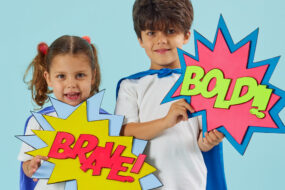‘She looked way too tiny to be wheeled off and have surgery’
Before she even took her first breath, Amaiya faced a daunting diagnosis. Mum Kiya Odell opens up about the family’s courageous journey with childhood heart disease.
It was during Kiya Odell’s routine 20-week scan that a sonographer detected a problem with baby Amaiya’s heart.
Further scans in Brisbane Hospital found Amaiya had transposition of the great arteries.
“When I found out Amaiya had a heart defect, I immediately thought the worst,” Kiya says.
Amaiya arrived into the world via emergency C-section, and was taken immediately for urgent tests before Kiya had a chance to hold her.
A significant milestone etched in Kiya’s memory was when, after five long days, she finally cradled her baby girl for the very first time.
“She had so many tubes, like a ventilator and other things, that I couldn’t even see her face,” Kiya says.
“It was a very assisted cuddle because of all the tubes, the nurses all hovered around to make sure none of the tubes popped out of place.”
Around a week later, Amaiya began experiencing episodes of supraventricular tachycardia, where her heart rate soared to around 280 bpm.
After Amaiya was stabilised, she underwent heart surgery.
“She looked way too tiny to be wheeled off and have surgery,” Kiya says.
While Amaiya still requires regular cardiac specialist check-ups and continuous monitoring of her heart rate, she is now thriving.
The bubbly and cheerful 16-month-old has recently started walking and loves playing with her puppy Bruno.
During the ordeal, a friend put Kiya in touch with HeartKids, a not-for-profit organisation supporting people impacted by childhood heart disease.
“We are so grateful for the support we got from HeartKids,” Kiya says.
“It’s very comforting knowing you’ve got someone there who understands what you’re going through, especially in such a tough time.”
What is childhood heart disease?
Childhood heart disease is a general term for a range of conditions that affect the way the heart works.
Heart defects can be congenital or acquired during childhood.
Congenital heart defects are present from birth and are the most common type of birth defect.
Acquired heart defects mean they develop later in childhood.
How is congenital heart disease treated?
Paediatric and fetal cardiologist Professor Gary Sholler AM says some congenital heart defects can be mild and don’t need treatment while others can be complex and may need many surgeries over several years.
He says it is important to remember it’s not just about children.
“Every child has parents, carers, siblings and grandparents, in some combination,” Prof Sholler says.
“All these people are touched, in some way or other, by the fact that the child has to travel this journey of heart abnormality.
“So the care needs to be delivered not only to the child from a medical perspective but also to emotionally support the whole family group.”
What can you do to help?
HeartKids chief executive Lesley Jordan says the organisation aims to give everyone a fighting chance to live a long or fulfilling life.
The organisation helps in a range of ways, such as:
- Providing one-on-one hospital support
- Helping families travel for medical appointments
- Providing educational resources
- Funding research
- Providing a helpline
HeartKids’ Sweetheart Day is celebrated on February 14 to raise awareness around congenital heart disease and childhood onset heart disease, and to raise vital funds via donations.
“What we’re asking people to do this Sweetheart Day is rather than purchase chocolates, flowers or teddy bears that have a limited life, to actually give a gift that will have a lifelong impact,” Ms Jordan says.
“There is no cure for CHD, but treatment options are improving.”
For more on heart health:
- Can small diet changes really impact heart disease risk?
- What can your calcium score tell you about heart health?
- Check your heart: The death of two champs has sparked health call
Written by Bianca Carmona.






